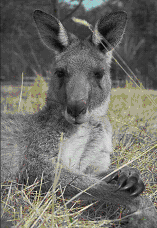Languages
PPBio Australia


PPBio Australasia is led by Professor Jean-Marc Hero and is based out of the Environmental Futures Research Institute, Griffith University, Gold Coast.
There are three PPBio grids and one set of modules installed in Australia (Figure 1). There is one set of modules installed at Chitwan National Park, Nepal. The details of the grid and modules can be seen in Table 1.
|
Location |
Type |
Number of transects |
Year commenced |
Major Habitats |
|
Karawatha Forest Park |
Grid |
32 |
2007 |
Dry eucalypt forest |
|
Lake Broadwater |
Grid |
18 |
2007 |
Dry eucalypt forest |
|
Currawinya National Park |
Grid |
40 |
2010 |
Semi-arid shrubland |
|
Cooloola |
Module |
4 |
2010 |
Coastal wallum heath |
|
Chitwan National Park (Nepal) |
Module |
16 |
2007 |
Lowland forest and grassland |
Table 1. Details of the PPBio grids and modules installed by PPBio Australasia.

Figure 1. Locations of PPBio Australasia grids and module. The main image shows Curawinya, Lake Broadwater and Karawatha from west to east. The Cooloola module is the most northern Australian location for PPbio plots. Chitwan National Park modules are shown in the inset.
Karawatha Forest Park
Karawatha Forest Park (27°38’00”S, 134°04’56”E) is a 909 ha peri-urban forest governed by the Brisbane Shire Council. The first established Australasian PPBio site was initiated in collaboration with Brisbane Shire Council, South-east Queensland Catchments and the Nature Refuge Landholders Association in 1997. Vegetation types and structure within Karawatha Forest Park (KFP) have been influenced by past management practices. The local region was logged from the 1850s to the late 1950s for firewood, housing material and coal production. Urbanisation and housing encroachment through partial clearing reached the area in the early 1980s. Many parts of Karawatha are burned every one or two years, mainly by low intensity fires. KFP is currently used for bushwalking, picnicking, mountain biking and nature research. The vegetation is characterised by remnant mixed eucalypt forest with a predominately grassy understorey and melaleuca forest with a fern and herbaceous understorey.
Unlike other Australasian PPBio sites, transects were placed 500 m apart to ensure adequate replication. Scientific studies have shown that this spacing is adequate for independence of data. Most scientific research conducted at KFP has been undertaken by Honours students. So far, ten Honours studies have used the KFP PPBio grid for scientific research. Completed theses are listed in Table 2.
|
Author |
Year |
Topic |
|
James Cifuentes |
2016 |
Variation in ant composition |
|
Sarah Butler |
2007 |
Variation in woody vegetation |
|
Matthew Davies |
2012 |
Comparative performance of acoustic recorders, citizen scientists and an expert in birdwatching performance |
|
Ryan Hughes |
2007 |
Bird composition and abundance variation |
|
Saara Kampman |
2008 |
Variation of lizard assemblage |
|
Mark Le Pla |
2012 |
Bird composition variation |
|
Alexa Mossaz |
2010 |
Koala activity and their tree choice |
|
Catherine Ogden |
2009 |
Abundance of hollow-bearing trees and their occupancy by fauna |
|
Chays Ogston |
2010 |
Variation in small mammal composition and distribution |
Table 2. A list of Honours thesis that have used the PPBio grid at Karawatha Forest Park.
The PPBio grid at KFP is also became part of a Terrestrial Ecosystem Research Network (TERN) SuperSite in 2010. The Australian SuperSite Network (ASN) is a national network of multidisciplinary ecosystem observatories. The ASN includes ten SuperSites that each represent a significant Australian biome. The network covers all States and Territories and spans a wide range of environmental conditions.

Figure 2. Karawatha Forest Park with PPBio plots.
Lake Broadwater
Lake Broadwater (27°12’35”S, 151°06’45”E) is a Conservation Park and Resources Reserve that is run by the Queensland Department of National Parks, Sporting and Racing. The centrepiece of the park is a naturally-occurring shallow freshwater lake that is lined by Eucalyptus tereticornis. Vegetation is predominantly Eucalyptus woodland with a grassy understorey. Land clearing for the sake of grazing has occurred historically, before the land was gazetted as an Environmental Park in 1981 and a Conservation Park in 1994. Much of the Park and Reserve is regrowth and woody vegetation can be patchy as the distance from the lake increases. The surrounding area is used for cropping, grazing and gas extraction.
Eighteen PPBio transects have been installed over 2007-2009. The transects have been visited yearly since 2007 to conduct undergraduate research with mammal, bird, weed, reptile and amphibian data collected yearly.

Figure 3. PPBio plot distribution at Lake Broadwater, Queensland
Currawinya
There are 40 PPBio transects at Currawinya National Park, Queensland (28°50’23”S, 144°29’34”E). Currawinya contains a 2487 ha enclosure for the purpose of breeding the nationally Threatened greater bilby (Macrotis lagotis). During 2010-2012, thirty transects were installed inside the enclosure and 10 transects were installed outside the enclosure. The environment within and surrounding the enclosure is semi-arid with the predominant vegetation being shrubland comprising of Eremophila and Dodonaea species. Low red sand dunefields occur at the topographic high points, while water runs into claypans.
Monitoring of bilbies and rabbits has occurred since 2011 and research on the PPBio transects has documented their decline due to a cat invasion. Mammal activity, including goat and kangaroo activity has been monitored on transects outside the enclosure. There are marked differences in vegetation condition and cover either side of the enclosure fence due to pest herbivores.

Figure 4. Plot layout at Currawinya National Park. The enclosure fence is shown in black.
Cooloola
Two modules, consisting of one and three PPBio transects each, have been installed at the Great Sandy National Park (26°15’37”S, 153°03’24”E) in southern Queensland. The modules are 5 km apart, with transects being 1 km apart within a module (Figure 5). As is the case with Lake Broadwater and Currawinya, the national park is run by the Queensland Department of National Parks, Sporting and Racing. Habitat is wallum heath on a sand dune system. A study on groundwater movement has been undertaken on the modules.

Figure 5. Plot layout at Cooloola. There is a 5 km gap between the northern-eastern and southern plot.
Chitwan National Park
Sixteen PPbio transects have been installed at Chitwan National Park (27°32’47”N, 84°29’42”E) in lowland Nepal over a period from 2007 to 2011. There are five transects in riverine forest, one in grassland and ten transects in Sal forest (Figure 6). A complex collaboration with World Wildlife Fund Nepal, the National Trust for Nature Conservation (NTNC), the Department of National Parks and Wildlife Conservation (DNPWC), the Center for Molecular Dynamics and Tribhuvan University has resulted in seven student research trips conducted by staff and students from Australia and Nepal. The PPBio Nepal program focuses on research development and education for Australian students and Nepalese staff and students. Since 2007, monitoring of woody vegetation, small and large mammals, birds, weeds and DNA sampling has taken place. The goal of the PPBio Nepal is to hand over management of the PPBio grid to Nepal.

Figure 6. Plot layout in Chitwan National Park, Nepal.
Publications involving PPBio Australasia
Haughland, D.L., Hero, J.-M., Schieck, J., Castley, J.G., Boutin, S., Sólymos, P., Lawson, B.E., Holloway, G. & Magnusson, W.E. (2010). Planning forwards: biodiversity research and monitoring systems for better management. Trends in Ecology and Evolution 1210, 199-200.
Hero J.-M, Castley J.G., Malone M., Lawson B. & Magnusson, W.E. (2010). Long-term ecological research in Australia: innovative approaches for future benefits. Australian Zoologist 35, 90–102.
Hero, J.-M, Lollback, G., Edwards, N., Butler, S., Steven, R., Shuker, J., Simpkins, C. & Castley, G. (2012). PPBio Australasia Long Term Ecological Research Sites – flora and fauna database. In: Dengler, J., Chytrý, M., Ewald, J., Finckh, M., Jansen, F., Lopez-Gonzalez, G., Oldeland, J., Peet, R.K., Schaminée, J.H.J. [Eds.]: Vegetation databases for the 21st century. Biodiversity & Ecology 4, 316-317.
Hero, J.-M., Castley, J.G., Butler, S.A. & Lollback, G.W. (2013). Biomass estimation within an Australian eucalypt forest: meso-scale spatial arrangement and the influence of sampling intensity. Forest Ecology and Management 310, 547–554.
Hero, J.-M., Lollback, G.W., Shuker, J. & Castley, J.G. (2013). PPBio LTER plots in sub-tropical eucalypt woodland of Karawatha Forest within the TERN SEQ Peri-urban Supersite. Feature Box 8.8 pp. 320-322 In: Chapter 8, Lindenmayer, D., Prober, S., Crane, M., Michael, D., Okada, S., Kay, G., Keith, D., Montague-Drake, R. & E. Burns. Temperate eucalypt woodlands. In Biodiversity and Environmental Change: Monitoring, Challenges and Direction. Eds: Lindenmayer, D., E. Burns, N. Thurgate & A. Lowe. CSIRO Publishing. Melbourne, Australia.
Lollback, G. W., Mebberson, R., Evans, N., Shuker, J. D., & Hero, J.-M. (2015). Estimating the abundance of the bilby (Macrotis lagotis): a vulnerable, uncommon, nocturnal marsupial. Australian Mammalogy 37, 75-85.
Narayan, E.J., Evans, N. & Hero J.-M. (2014). Monitoring physiological stress in semi-free ranging populations of an endangered Australian marsupial, the Greater Bilby (Macrotis lagotis). European Journal of Wildlife Research 60, 727-735.
Centre for Innovative Conservation Strategies


